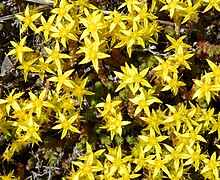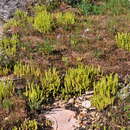Associations
provided by BioImages, the virtual fieldguide, UK
Foodplant / miner
larva of Apion sedi mines stem (after leaf) of Sedum acre
Foodplant / sap sucker
adult of Chlamydatus evanescens sucks sap of Sedum acre
Remarks: season: 6-, late 8-5
Brief Summary
provided by Ecomare
Wall-pepper has various names, each one emphasizing a particular feature or two. The name wall-pepper comes from the fact that it can grow in notches in a stone wall and it has a strong peppery flavor. Sometimes it takes awhile for the sharpness to take effect, but once it does ... It's not so strange that this plant is used as a flavoring. Because it is a succulent plant, storing water in its fleshy leaves, it is resistant to drought. In general, you don't tend to notice this plant among all the other vegetation. However when it blossoms, the ground turns into a sea of yellow stars!
- license
- cc-by-nc
- copyright
- Copyright Ecomare
Comprehensive Description
provided by North American Flora
Sedum acre
Insert the synonym: Sedum minimum Nieuwl. Am. Midi. Nat. 4: 56. 1915. Add to the illustrations: Britt. & Brown, 111. Fl. ed. 2. /. 2136; G. T. Stevens, 111. Guide pi. 58, f. 6.
62. Insert:
2a. Sedum potosinum Rose, Contr. U. S. Nat. Herb. 13: 300. 1911.
Stems low and weak, at first erect, but soon prostrate or at most ascending. Leaves closely set, ascending, nearly terete, obtuse, 6-8 mm. long, pale-green, glabrous, slightly glaucous; inflorescence (usually?) an equilateral raceme; pedicels short, 1-2 mm. long; sepals linear, distinct nearly to the base, 3 mm. long; petals white or slightly tinged with pink, widely spreading, 6-7 mm. long.
Type locality: Near San Luis Potosi, San Luis Potosi. Distribution: San Luis Potosi.
- bibliographic citation
- Per Axel Rydberg. 1918. ROSACEAE (conclusio). North American flora. vol 22(6). New York Botanical Garden, New York, NY
Comprehensive Description
provided by North American Flora
Sedum acre L. Sp. PL 432. 1753
Perennial, densely tufted, matted, glabrous ; sterile branches prostrate, the flowering ones 2-8 cm. high. lyeaves sessile, alternate, ovate, thick, imbricated, yellowish-green, entire, about 3 mm. long; cyme 2-3-forked, its branches 1-2.5 cm. long; flowers sessile, about 8 mm. broad; petals yellow, linear-lanceolate, acute, 3-4 times as long as the ovate sepals ; follicles spreading, 'h-A mm. long, tipped with a slender style.
Type locality : In dry sterile fields, Burope.
Distribution : On rocks and along roads, Nova Scotia to Ontario, New York, Pennsylvania and Virginia. Naturalized from Europe.
- bibliographic citation
- John Kunkel SmaII, George Valentine Nash, Nathaniel Lord Britton, Joseph Nelson Rose, Per Axel Rydber. 1905. ROSALES, PODOSTEMONACEAE, CRASSULACEAE, PENTHORACEAE and PARNASSIACEAE. North American flora. vol 22(1). New York Botanical Garden, New York, NY
Sedum acre
provided by wikipedia EN
Sedum acre, commonly known as the goldmoss stonecrop,[1] mossy stonecrop,[2] goldmoss sedum, biting stonecrop,[3] and wallpepper, is a perennial flowering plant in the family Crassulaceae. It is native to Europe, but also naturalised in North America, Japan, and New Zealand.
Description
Biting stonecrop is a tufted evergreen perennial that forms mat-like stands some 5 to 12 cm (2 to 5 in) tall. For much of the year, the stems are short, semi-prostrate and densely clad in leaves. At the flowering time in June and July, the stems lengthen and are erect, somewhat limp and often pinkish-brown with the leaves further apart. The leaves are alternate, fleshy and shortly cylindrical with a rounded tip. They are also sometimes tinged with red. The starry flowers form a three to six-flowered cyme. The calyx has five fleshy sepals fused at the base, the corolla consists of five regular bright yellow petals, there are ten stamens, a separate gynoecium and five pistils. The fruit consists of five united, many-seeded follicles. The leaves contain an acrid fluid that can cause skin rashes.[4]
Habitat
Biting stonecrop is a low-growing plant that cannot compete with more vigorous, fast-growing species. It is specially adapted for growing on thin dry soils and can be found on shingle, beaches, drystone walls, dry banks, seashore rocks, roadside verges, wasteland and in sandy meadows near the sea.[4]
Cultivation
Biting stonecrop spreads when allowed to do so, but is easily controlled, being shallow-rooted. It is used in hanging baskets and container gardens, as a trailing accent, in borders, or as groundcover. This plant grows as a creeping ground cover, often in dry sandy soil, but also in the cracks of masonry. It grows well in poor soils, sand, rock gardens, and rich garden soil, under a variety of light levels.
References
-
^ USDA, NRCS (n.d.). "Sedum acre". The PLANTS Database (plants.usda.gov). Greensboro, North Carolina: National Plant Data Team. Retrieved 9 November 2015.
-
^ Dickinson, T.; Metsger, D.; Bull, J.; & Dickinson, R. (2004) ROM Field Guide to Wildflowers of Ontario. Toronto:Royal Ontario Museum, p. 243.
-
^ David Chapman (2008). Exploring the Cornish Coast. Penzance: Alison Hodge. p. 44. ISBN 9780906720561.
-
^ a b "Biting stonecrop: Sedum acre". NatureGate. Retrieved 29 December 2013.
Wikimedia Commons has media related to
Sedum acre.

- license
- cc-by-sa-3.0
- copyright
- Wikipedia authors and editors
Sedum acre: Brief Summary
provided by wikipedia EN

Sedum acre (L.) Link,
Batiscan,
Quebec,
Canada 
Goldmoss stonecrop
Sedum acre, commonly known as the goldmoss stonecrop, mossy stonecrop, goldmoss sedum, biting stonecrop, and wallpepper, is a perennial flowering plant in the family Crassulaceae. It is native to Europe, but also naturalised in North America, Japan, and New Zealand.
- license
- cc-by-sa-3.0
- copyright
- Wikipedia authors and editors


 Sedum acre (L.) Link, Batiscan, Quebec, Canada
Sedum acre (L.) Link, Batiscan, Quebec, Canada  Goldmoss stonecrop
Goldmoss stonecrop